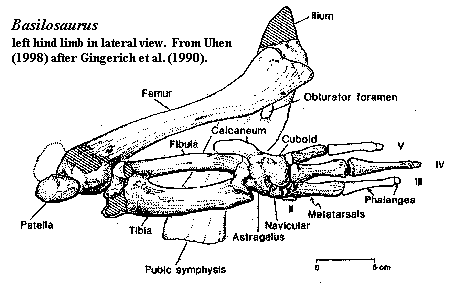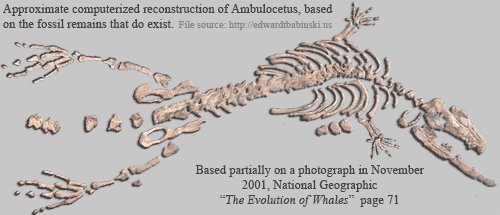We don't. We have virtually complete skeletons of Basilosaurus isis. (Although the species was known for many years before a particularly complete specimen revealed that it had very small, but perfectly formed, rear legs and feet.)
I just made the comment about the "skull alone" probably being too heavy to lift because you'd said you couldn't fill a single hand with the evidence of transitional forms. (Actually you said "missing links".)
... if it had fins or legs.
Uh, btw, whales don't have "fins" in the position of the front limbs. They're called "flippers". Granted whales do have a "dorsal 'fin'," but of course it's entirely different in structure and developmental origin from the fins of fishes, as of course is predicted and required by evolution since whales evolved from terrestrial tetrapods (land animals) that had long ago lost their fishy fins.
I've seen some of your proof which consisted of bones where legs should be but turned into a fin.
??? I can't make out what you're trying to say here. In any case, legs have never turned into fins. It happened the other way around.
Now they say it used to be a leg. Yeah right.
Yeah wrong. No evolutionist has ever said of a fin that it used to be a leg. Again the evolution went the other way. Fins became legs.
I'll tell you what, you show me a true whale of any age and show me the four legs on it.
Basilosaurus isis, an archaic cetecean of the Eocene, and the geologically most recent legged whale known, had flippers for forelimbs. This it didn't have "four legs". But I'd be happy to show you the rear legs:

For a clear picture of the actual fossils (fibula/tibula through the foot) see Gingerich's webpage (won't seem to let me embed the pic here). It's Figure 4, about a quarter of the way down the page. Also Figure 5 is a very complete fossil of Dorudon atrox, which is quite similar in overall form to Basilosaurus, and also retains the tiny hind limb.
Apart from Basilosaurus (and the other basilosaurids with rear limbs) there are no less than three other fossil whales with rear limbs. For the sake of space we'll ignore #3 in the sequence (Rodhocetus) which appears to have developed a powerful swimming tail, starting the rear limbs on the path to vestigial status. We'll also ignore #1 (Pakicetus). Although it's recognized as a full cetecean, based principally on distinctive skull morphology particular to the order, and had some aquatic adaptations, it was still structurally a terrestrial creature. (Note you could say the same about a sea otter. It's structurally terrestrial, even though it spends most of its time in the water.)
So then here's #2, Ambulocetus natans ("the walking whale that swims"). Unlike #3 it doesn't have a tail that is sufficient to provide locomotion in the water, and therefore almost certainly used its rear limbs to swim with, as well as for limited locomotion on land. So this "four legs on it," as the forelimbs are not mere flippers but have flexible wrists:
Actual fossil, unreconstructed (just arranged in body order). All these bones found in a single location belonging to a single individual.
This partial reconstruction mirrors actual fossil bones from side to side to give a more complete view. (I.e. it's a "reconstruction," but based only on bones actually found.)
And finally here's a complete reconstruction (i.e. extrapolated to give an approximation of the complete skeleton).
And one suggestion of what it might have looked like in life. 